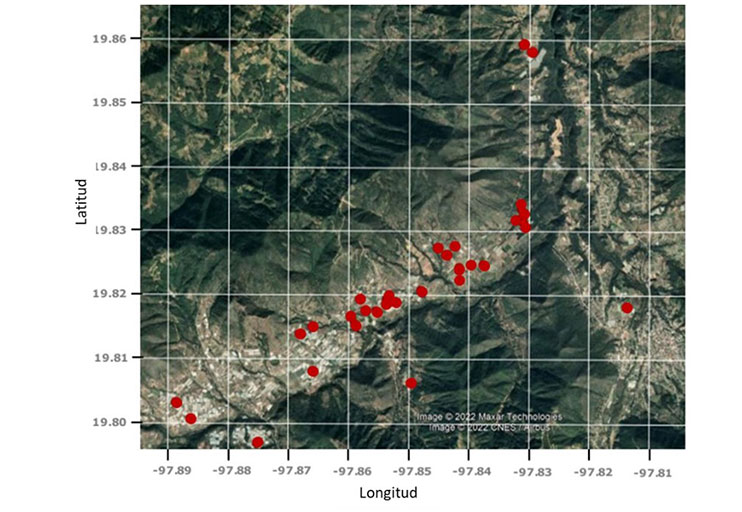Use and abuse of fertigation. Modification of the soil in greenhouses in small-scale agriculture
DOI:
https://doi.org/10.29312/remexca.v14i6.3112Keywords:
edaphic chemical environment, fertilizers, productivity, tomatoAbstract
Protected agriculture helps improve agricultural productivity, but if the management is not adequate, it will increase the risk of affecting the environment and the profitability of crops. Therefore, in the municipality of Tetela de Ocampo, Puebla, in 2021, the chemical environment of the soil in greenhouses in the region that use fertigation was evaluated. To identify the details of agricultural activities, a questionnaire prepared specifically was applied to cooperating farmers, collecting a composite soil sample (five subsamples) per unit of production evaluated and uncultivated lands were included as a reference of the initial condition. The analysis of the samples was based on the NOM-021-RECNAT-2000 (NOM). The average annual yield of tomato is 31 ±7.6 kg m-2 and 87% of greenhouses have an area of less than 3 000 m2. They have technical assistance provided by companies and individuals, which include training courses and periodic soil analysis. In this study, excessive levels of all the chemical indicators established in the NOM were detected in the soil; nevertheless, the same fertilization program that has been carried out for several years in the region continues.
Downloads
References
Barak, P.; Jobe, B. O.; Krueger, A. R.; Peterson, L. A. and Laird, D. A. 1997. Effects of long-term soil acidification due to nitrogen fertilizer inputs in Wisconsin. Plant Soil. 197(1):61-69. https://www.jstor.org/stable/42948199. DOI: https://doi.org/10.1023/A:1004297607070
Barrow, N. J. 1978. The description of phosphate adsorption curves. J. Soil Sci. 29(4):447-462. https://doi.org/10.1111/j.1365-2389.1978.tb00794.x. DOI: https://doi.org/10.1111/j.1365-2389.1978.tb00794.x
Cameron, K. C.; Di, H. J. and Moir, J. L. 2013. Nitrogen losses from the soil/plant system: a review. Ann. Appl. Biol. 162(2):145-173. https://doi.org/10.1111/aab.12014. DOI: https://doi.org/10.1111/aab.12014
Coitiño-López, J.; Barbazán, M. y Ernst, O. 2015. Conductividad eléctrica aparente para delimitar zonas de manejo en un suelo agrícola con reducida variabilidad en propiedades fisicoquímicas. Agrociencia Uruguay. 19(1):102-111. http://www.scielo.edu.uy/scielo. php?script=sci-arttext&pid=S230115482015000100012&lng=es&tlng=pt.
Griffioen, J. 2001. Potassium adsorption ratios as an indicator for the fate of agricultural potassium in groundwater. J. Hydrol. 254(1-4):244-254. https://doi.org/10.1016/S0022-1694(01)00503-0. DOI: https://doi.org/10.1016/S0022-1694(01)00503-0
Hernández-Mendoza, T. M. y Galvis-Spinola, A. 2017. Productividad de la caña de azúcar por régimen hídrico y uso de fertilizantes en suelos someros. Interciencia. 42(4):218-223. https://www.interciencia.net/wp-content/uploads/2017/08/218-5856-hernandez-42-4.pdf.
INEGI. 2009. Instituto Nacional de Estadística y Geografía. Prontuario de información geográfica nacional. https://www.inegi.org.mx/contenidos/app/mexicocifras/datos-geograficos/21/21172.pdf.
Ju, M.; Xu, Z.; Wei-Ming, S.; Guang-Xi, X. and Zhao-Liang, Z. 2011. Nitrogen balance and loss in a greenhouse vegetable system in southeastern China. Pedosphere. 21(4):464-472. https://doi.org/10.1016/S1002-0160(11)60148-3. DOI: https://doi.org/10.1016/S1002-0160(11)60148-3
Mundo-Coxca, M.; Jaramillo-Villanueva, J. L.; Morales-Jiménez, J.; Macías-López, A. y Ocampo-Mendoza, J. 2020. Caracterización tecnológica de las unidades de producción de tomate bajo invernadero en Puebla. Rev. Mex. Cienc. Agríc. 11(5):979-992. https://doi.org/10.29312/remexca.v11i5.2010. DOI: https://doi.org/10.29312/remexca.v11i5.2010
NOM. 2002. Norma Oficial Mexicana. NOM-021-RECNAT-2000 establece las especificaciones de fertilidad, salinidad y clasificación de suelos. Estudios, muestreo y análisis. Diario oficial de la federación. http://dof.gob.mx/nota-detalle.php?codigo= 756861&fecha=07/12/200.
Sánchez-González, M. J.; Sánchez-Guerrero, M. C.; Medrano, E.; Porras, M. E.; Baeza, E. J.; García, M. L. y Lorenzo, P. 2014. Efectos de la salinidad y el enriquecimiento carbónico en invernadero sobre la bioproductividad y el contenido de nutrientes en un cultivo de tomate híbrido Raf (cv. Delizia). Acta Hortic. 66:78-84. http://www.sech.info/ ACTAS/index.php?d=main.
SIAP. 2021. Sistema de información agrícola y pesquera. Producción anual agrícola. https://www.gob.mx/siap/acciones-y-programas/produccion-agricola-33119.
Yasuor, H.; Yermiyahu, U. and Ben-Gal, A. 2020. Consequences of irrigation and fertigation of vegetable crops with variable quality water: Israel as a case study. Agric. Water Manag. 242:106362. 10 p. https://doi.org/10.1016/j.agwat.2020.106362.
Zörb, C.; Geilfus, C. M. and Dietz, K. J. 2019. Salinity and crop yield. Plant biology. 21:31-38. https://doi.org/10.1111/plb.12884.

Published
How to Cite
Issue
Section
License
Copyright (c) 2023 Revista Mexicana de Ciencias Agrícolas

This work is licensed under a Creative Commons Attribution-NonCommercial 4.0 International License.
The authors who publish in Revista Mexicana de Ciencias Agrícolas accept the following conditions:
In accordance with copyright laws, Revista Mexicana de Ciencias Agrícolas recognizes and respects the authors’ moral right and ownership of property rights which will be transferred to the journal for dissemination in open access. Invariably, all the authors have to sign a letter of transfer of property rights and of originality of the article to Instituto Nacional de Investigaciones Forestales, Agrícolas y Pecuarias (INIFAP) [National Institute of Forestry, Agricultural and Livestock Research]. The author(s) must pay a fee for the reception of articles before proceeding to editorial review.
All the texts published by Revista Mexicana de Ciencias Agrícolas —with no exception— are distributed under a Creative Commons License Attribution-NonCommercial 4.0 International (CC BY-NC 4.0), which allows third parties to use the publication as long as the work’s authorship and its first publication in this journal are mentioned.
The author(s) can enter into independent and additional contractual agreements for the nonexclusive distribution of the version of the article published in Revista Mexicana de Ciencias Agrícolas (for example include it into an institutional repository or publish it in a book) as long as it is clearly and explicitly indicated that the work was published for the first time in Revista Mexicana de Ciencias Agrícolas.
For all the above, the authors shall send the Letter-transfer of Property Rights for the first publication duly filled in and signed by the author(s). This form must be sent as a PDF file to: revista_atm@yahoo.com.mx; cienciasagricola@inifap.gob.mx; remexca2017@gmail.
This work is licensed under a Creative Commons Attribution-Noncommercial 4.0 International license.


